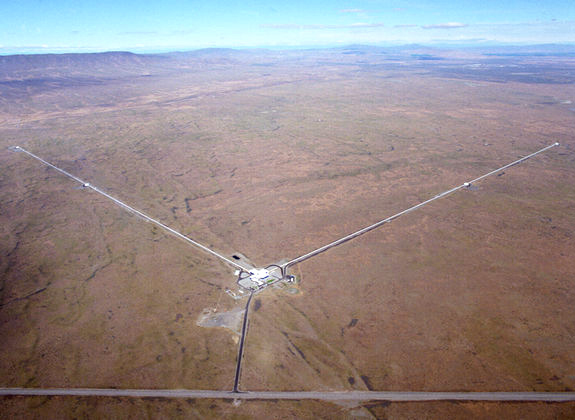Laser Interferometer Gravitational-Wave Observatory (LIGO) is a pair of facilities built to detect gravitational waves, a type of radiation created by the movement of matter through space. LIGO consists of three detectors—two near Richland, Washington, and one in Livingston, Louisiana. The U.S. National Science Foundation sponsors LIGO, which is operated by the California Institute of Technology (Caltech) and the Massachusetts Institute of Technology (MIT).

The LIGO detectors are designed to detect gravitational waves created by such violent cosmic events as collisions between neutron stars, the smallest and densest type of star known. It may also detect gravitational waves produced by collisions between black holes, objects whose gravitational force is so strong that nothing can escape from it. Neutron stars and black holes are created from exploding stars called supernovae. LIGO could also observe signals produced by the supernovae.
The LIGO detectors consist of large interferometers, devices that use light waves or other waves to make precise measurements. A LIGO interferometer splits light from a laser into two beams and sends them along separate, perpendicular channels or arms 2 1/2 miles (4 kilometers) in length. Mirrors at the end of each arm reflect the beams, which come back together at the beam splitter. As the beams recombine, their light waves interfere with each other, creating a pattern of varying intensity known as an interference pattern. Minor differences in the lengths of the two paths can create noticeable changes in the interference pattern.
Gravitational waves squeeze and stretch space in perpendicular directions as they move through it. Such a wave passing through a LIGO interferometer changes the length of one arm compared to the other by an amount smaller than the diameter of an atomic nucleus. The resulting change in the interference pattern registers in the LIGO detectors, signaling the passage of a gravitational wave.
Scientists at LIGO share data with three sister observatories in operation in other parts of the world. The European Gravitational Observatory (EGO) interferometer, called Virgo, is a 1.8-mile (3-kilometer) device located near Pisa, Italy. The United Kingdom and Germany jointly administer the GEO600 interferometer located near Hanover, Germany. This is a smaller gravitational wave detector at only 2,000 feet (600 meters) in length that serves mostly as a test site to develop systems for use in future detectors. The 1.8-mile (3-kilometer) Kamioka Gravitational Wave Detector (KAGRA) was built at a zinc mine in Kamioka, Japan. It began collecting data in 2020. Having a number of detectors observing simultaneously allows scientists to determine the source of gravitational waves with greater accuracy.
LIGO began observations in 2002. In 2005, scientists had improved the interferometers to their target sensitivities, but were still unable to detect gravitational waves. However, a program of upgrades significantly improved the sensitivities of the interferometers. In 2016, researchers at the observatory announced that they had detected gravitational waves coming from two colliding black holes. The gravitational waves had been detected by LIGO on Sept. 14, 2015. In August 2017, gravitational waves from two merging black holes were detected at both LIGO and Virgo facilities. Soon after, LIGO was shut down for an upgrade. It restarted its search for gravitational waves in April 2019.
In October 2017, scientists announced that a gravitational wave generated by the collision of two neutron stars was detected by the LIGO and Virgo observatories. The detection occurred in August, 2017. Other telescopes detected a flash from the collision in visible light, X rays, ultraviolet, infrared, and radio waves. Combining the telescope images with the gravitational wave signal, astronomers were able to locate the collision in the sky. They determined that the two neutron stars collided about 130 million light years away from Earth.
